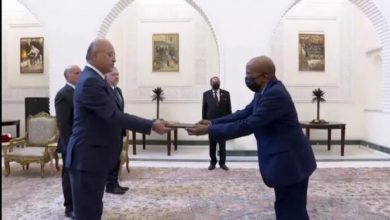Nuruddin Farah celebrates jubilee anniversary of debut novel
It is now 50 years since the publication of the first novel by the prolific Somali writer Nuruddin Farah. The novel entitled, From A Crooked Rib, was first published by Heinemann in 1970. It is part of the great novels of the 1970s and 1960s that Heinemann published under the famous African Writers Series.
It is now 50 years since the publication of the first novel by the prolific Somali writer Nuruddin Farah. The novel entitled, From A Crooked Rib, was first published by Heinemann in 1970. It is part of the great novels of the 1970s and 1960s that Heinemann published under the famous African Writers Series.
It is the 80th in that defunct series that launched the literary fame of other major East African writers, such as: Ngugi wa Thiong’o of Kenya and Okot p’ Bitek of Uganda, Taban Lo Liyong of South Sudan, Peter Palangyo of Tanzania and Sellasie Sahle of Ethiopia. Writers who published under the series are now central parts of the canons of modern African literature and are read across the continent and its national curricula from West to East to Southern Africa.
Farah who, at 75 years of age, is one of the major faces of East African literature, comes from Baidoa in Somalia but has been living in exile since the collapse of the unitary republic of Somalia in 1991. Even in the dictatorships that tainted the dawn of Independence of Somalia of the sixties and seventies, Farah was always a son of the soil adrift in the winds of exodus, repeatedly living abroad as testament to the seasons of anomie in his natal land.
He once said Somalia carried him as a child and now adrift abroad, he uses his novels to carry the motherland in his mind, at least as stories to itch our consciences. “Somalia carried me and now it is my time to carry her,” he told a congregation at a Ford Foundation Lecture in Nairobi almost two decades ago.
The leading African literature critic from Kenya, Prof Simon Gikandi, who teaches at Princeton University in USA, describes the Somali novelist as one of the most important African authors. He believes Farah’s novels, with their backgrounds against Somalia’s sad national story, have consistently shown “the process by which nationalist euphoria became transformed into a discourse of loss and mourning.”
According to Derek Wright, who has conducted sustained studies on the many fiction prose of Farah, one of the greatest qualities they possess is the ability to tap the rich heritage of Somali oral tradition to showcase the resilient strength and revolutionary versatility of both the nation and its citizenry. Nuruddin has emerged as the foremost fictive chronicler of the modern story and history of the Somali nation and its postcolonial discontent.
For many years, he existed at the penumbra of his more famous agemate from Kenya, Ngugi. His origins in Somalia was always occluded in the traditional configuration of East Africa as a literary landscape occupied by Kenya, Uganda and Tanzania primarily owing to their British colonial experience and shared regional consciousness. Somalia was primarily colonised by Italy and the territories under British and French rule are not contiguous to Anglophone East African lands.
With postcolonial discourse centred in Makerere and later Nairobi and Dar, a writer from Somalia failed to attract regional critical appraisal even after publishing in the African Writers Series. Wright and other latter-day scholars, especially from the global North, did substantial work in the 1990s to highlight the achievements of Farah and other Somali novelists and poets.
Despite close to 20 literary works to his name, Nuruddin Farah remains a name that is marginal to literary audiences of Kenya, and the celebration last week of the 50th birthday of his first novel went almost unnoticed to many.
Yet as Gikandi and Wright observe above, here is a writer whose contributions to the regional traditions of East African literature is epic both in terms of output and aesthetic depth. Between 1971 and 2011, he published three trilogies of very captivating fiction, each with three novels that can best be read in unison. The first one is commonly referred to as, Variations on the Theme of African Dictatorship Trilogy. It brings together, Sweet and Sour Milk (1979); Sardines (1981) and Close Sesame (1983).
The second trilogy is called, Blood in the Sun Trilogy and brings together, Maps (1983), Gifts (1993) and Secrets (1998). The third and final trilogy, at least for now, brings together his novels published at the turn of the century, Links (2003), Knots (2007) and Crossbones (2011). The three novels together form the trilogy known commonly as the Past Imperfect Trilogy.
Apart from the trilogies, there are many other non-fiction and fiction works he has written. They demonstrate with abandon his unique artistic power as a chronicler and aesthetician of fine prowess. A sinewy one who milks history like camels to offer gourdful of narrative delicacies that continue to sate the appetite of readers both in Somalia and its transnational diasporas and beyond.
With the fanfare that accompanied the turning of Ngugi’s Weep, Not Child at 50 and Song of Lawino by Okot, the idea of celebrating the artistic genius and moral lessons of the quiet Somali genius is one that was both timely and necessary.
Meeting in Lavington, Nairobi at a coffee gathering under the stewardship of the versatile University of Nairobi critic, Tom Odhiambo, the lovers of literature who listened to Farah last week were participating in a refreshing dialogue of exiled writers and their troubled homelands.
Simultaneously they were inscribing Farah into the unfolding literary energy of Eastern Africa as we pursue regional integration, or even federation. Out of many, one can be formed. Unity can lie in diversity.
Indeed, From a Crooked Rib, out of Somalia’s troubled past and wandering son, is a must-read novel that invites us to accept it as one of the cornerstones of modern East African literature today.





